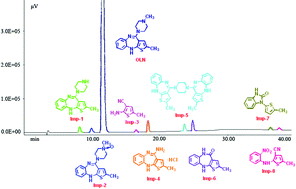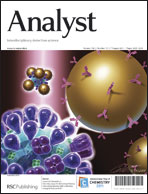A simple and stability-indicating reverse phase high performance liquid chromatographic (RP-HPLC) method was developed and validated for the determination of olanzapine (OLN) and related impurities in bulk drugs. Eight impurities were characterized respectively, and particularly a new process impurity from OLN synthesis was structurally confirmed as 1-(5-methylthionphen-2-yl)-1H-benzimidazol-2(3H)-one (Imp-7) by X-ray single crystal diffraction, MS, 1H NMR, 13C NMR and HSQC. A mechanism of formation pathway for Imp-7 was proposed. Optimum separation for OLN and eight related impurities was carried out on an Agilent Octyldecyl silica column (TC-C18, 4.6 mm × 250 mm, 5 μm) using a gradient HPLC method. The method was validated with respect to specificity, linearity, accuracy, precision, LOD and LOQ. Regression analysis showed good correlation (r2 > 0.9985) between the investigated component concentrations and their peak areas within the test ranges for OLN and eight impurities. The repeatability and intermediate precision, expressed as RSD, were less than 1.74%. The proposed stability-indicating method was suitable for routine quality control and drug analysis of OLN in bulk drugs.

You have access to this article
 Please wait while we load your content...
Something went wrong. Try again?
Please wait while we load your content...
Something went wrong. Try again?


 Please wait while we load your content...
Please wait while we load your content...